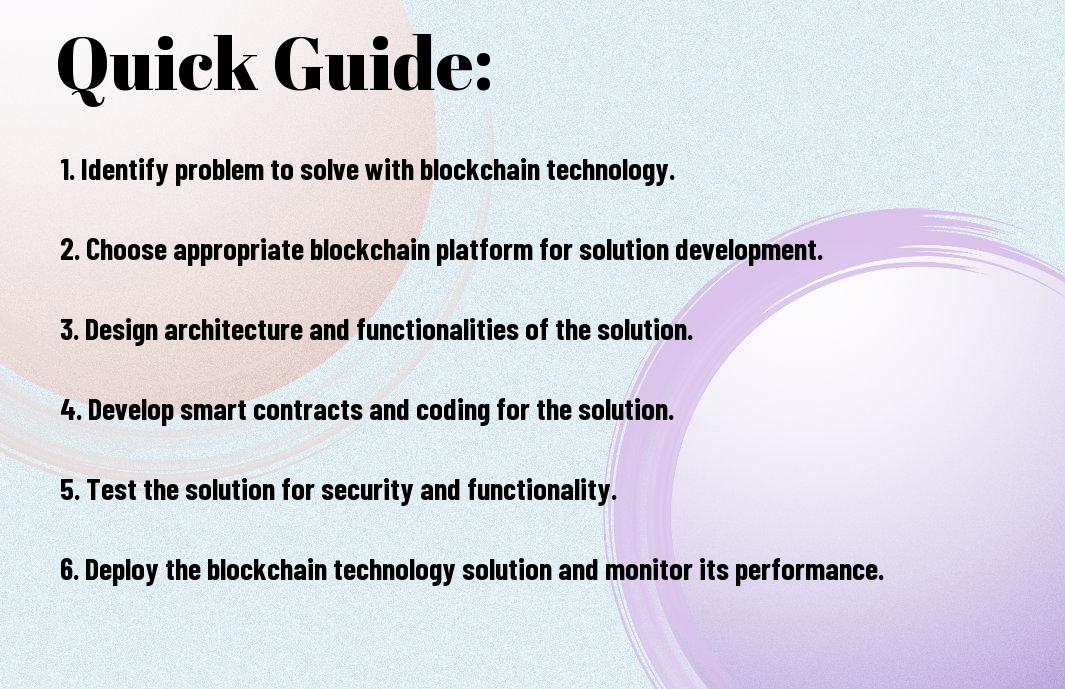Most businesses today are exploring the potential of blockchain technology to enhance security, transparency, and efficiency in their operations. Developing blockchain solutions requires a solid understanding of the technology and its applications. In this guide, we will walk you through the important steps to developing blockchain technology solutions successfully. If you’re interested in further exploring Blockchain Implementation in 2024: Roadmap, Costs, Skills, keep reading for expert tips and insights.

Exploring Blockchain Technology Types
The blockchain technology landscape has evolved over the years, giving rise to different types of blockchains. Understanding the various blockchain technology types is crucial for businesses looking to develop blockchain solutions tailored to their specific needs. Let’s explore into the different types of blockchain technologies to help you navigate this complex ecosystem effectively.
| Public Blockchains | Private Blockchains |
| Consortium Blockchains | Hybrid Blockchains |
| Permissioned Blockchains | Permissionless Blockchains |
| Enterprise Blockchains | Cryptocurrency Blockchains |
| Smart Contract Platforms | Regulatory-compliant Blockchains |
Public vs. Private Blockchains
Even though both public and private blockchains offer secure and immutable ledger systems, they differ significantly in terms of access control and transparency. Public blockchains are decentralized networks where anyone can participate, while private blockchains operate within a closed ecosystem with restricted access. Businesses must consider their specific requirements and use cases to determine the most suitable blockchain type for their projects.
Consortium Blockchains and Hybrid Models
Technology advancements have led to the emergence of consortium blockchains and hybrid models that combine features of both public and private blockchains. Consortium blockchains are governed by a group of entities, offering a more decentralized approach than private blockchains. These models provide a balance between security and efficiency, making them ideal for industries requiring greater transparency and control.
Models: Consortium blockchains and hybrid models present businesses with versatile options for implementing blockchain solutions that meet their unique requirements. These models offer a middle ground between full decentralization and centralized control, providing enhanced security and flexibility for diverse applications. Perceiving the nuances of these blockchain technology types is vital for making informed decisions when adopting blockchain solutions.

Step-by-Step Guide to Developing Blockchain Solutions
| Ideation and Conceptualizing Your Blockchain Project | Designing and Prototyping Your Blockchain Solution |
Ideation and Conceptualizing Your Blockchain Project
Assuming you have a blockchain project in mind, the ideation and conceptualization phase is crucial. Start by identifying the problem you aim to solve with blockchain technology. Research existing solutions and consider how blockchain can enhance or revolutionize the current process. Collaborate with stakeholders to gather insights and refine your project idea to align with the needs of end-users.
Designing and Prototyping Your Blockchain Solution
Some key steps in designing and prototyping your blockchain solution include creating a detailed system architecture, defining the logic for smart contracts, and building a user-friendly interface. Blockchain projects require careful planning to ensure scalability, security, and efficiency. It is important to conduct thorough testing to identify and rectify any potential vulnerabilities before deployment.
Essential Tips and Factors for Success
Despite the complexity of blockchain technology, developing solutions can be simplified by following some necessary tips and considering critical factors for success.
Tips for Efficient Blockchain Development
Some key tips for efficient blockchain development include:
- Plan your project thoroughly before submerging into development.
- Use existing blockchain platforms and tools to expedite the development process.
- Regularly test and iterate on your blockchain solution for optimal performance.
The success of your blockchain project heavily relies on applying these tips efficiently.
Critical Factors to Consider During Development
Some critical factors to consider during blockchain development are:
- Security measures to protect sensitive data and transactions.
- Scalability of the blockchain network as it grows in users and transactions.
- Regulatory compliance to avoid legal issues in different jurisdictions.
This underscores the importance of knowing and addressing these factors early in the development process.
Evaluating Your Blockchain Solution
Pros and Cons of Implementing Blockchain Technology
While considering implementing blockchain technology, it’s imperative to evaluate the pros and cons. A detailed comparison can help you make an informed decision. Here’s a breakdown of the advantages and disadvantages:
| Pros | Cons |
| Increased transparency | High initial setup costs |
| Enhanced security | Scalability challenges |
| Reduced transaction costs | Regulatory uncertainty |
| Improved traceability | Potential for data breaches |
Testing and Iteration for Improvement
Technology evolves rapidly, and blockchain solutions need thorough testing and iteration for continuous improvement. Running tests, debugging, and gathering feedback are crucial steps in refining your blockchain solution. Through this process, you can identify weaknesses, enhance performance, and ensure the reliability of your technology.
Summing up
Considering all points discussed in this guide, it is evident that developing blockchain technology solutions requires a deep understanding of the technology, its capabilities, and its potential applications. By following the steps outlined in this guide and collaborating with experienced professionals, individuals and businesses can successfully create innovative blockchain solutions that can revolutionize industries and enhance processes. Continuous learning, networking, and experimentation are necessary to stay on top of the fast-evolving blockchain landscape and leverage its benefits to the fullest.
FAQ
Q: What is blockchain technology?
A: Blockchain technology is a decentralized and distributed ledger technology that securely records transactions across a network of computers. Each block in the chain contains a number of transactions, and every time a new transaction occurs on the blockchain, a record of that transaction is added to every participant’s ledger.
Q: How can I develop blockchain technology solutions?
A: To develop blockchain technology solutions, you need to first understand the basics of blockchain technology and how it works. Then, you can choose a blockchain platform to work with, such as Ethereum or Hyperledger. Next, you can start developing smart contracts and decentralized applications (DApps) using programming languages like Solidity or Go. Finally, don’t forget to test your solutions thoroughly to ensure security and functionality.
Q: What are some common use cases for blockchain technology solutions?
A: Blockchain technology solutions can be applied to various industries and use cases, including supply chain management, healthcare data management, identity verification, voting systems, and financial transactions. By using blockchain technology, organizations can enhance transparency, security, and efficiency in their operations.
